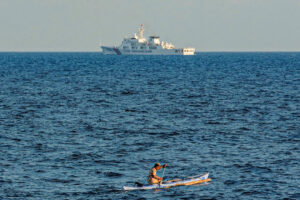By Kenneth Christiane L. Basilio, Reporter
THE Armed Forces of the Philippines (AFP) on Tuesday rejected a Chinese claim that its naval forces conducted sea and air patrols in the South China Sea last week, saying what it was the continuous “illegal presence” of Chinese ships in the disputed sea.
The statement by China’s Southern Theater Command was meant to reinforce Beijing’s position on key contested features in the waterway, and an attempt to shape the narrative in the South China Sea dispute, Philippine military spokeswoman Francel Margareth Padilla told a news briefing.
The Chinese Embassy in Manila did not immediately reply to a Viber message seeking comment.
“No alleged coordinated air and sea patrols were conducted as reported,” she said. “What was monitored by the Philippine Navy was the continued illegal presence of the People’s Liberation Army-Navy and China’s Coast Guard in our maritime zones.”
“This report is another attempt on misinformation, disinformation and malinformation to shape the domestic and international narrative favorable to the illegal claims in our maritime zones of the Communist Party of China,” she added.
China’s Southern Theater Command held drills in the South China Sea on Saturday, according to a China Military Online report on Sunday. It said Chinese troops were on “high alert” to guard Beijing’s claims in the contested waterway.
On that day, the Philippine Navy and Japan Maritime Self-Defense Force held naval drills in the same water. The Philippines’ newest missile frigate BRP Miguel Malvar and Japanese destroyer JS Takanami performed anti-submarine warfare drills and cross-deck landing exercises involving a helicopter.
A Chinese Navy warship tailed the Philippine and Japanese ships during the joint naval drills, Philippine Navy spokesman Rear Admiral Roy Vincent T. Trinidad told the same briefing.
“There was a PLA-Navy that was tailing the formation that also launched and recovered drones,” he said.
The Philippines and China have repeatedly clashed over disputed South China Sea features, fueling tensions as both uphold their claims in the vital trade route.
China claims nearly all of the South China Sea via a U-shaped, 1940s nine-dash line map that overlaps with the exclusive waters of the Philippines and neighbors like Vietnam and Malaysia.
A United Nations-backed tribunal in 2016 voided China’s sweeping claims for being illegal, a ruling that Beijing does not recognize.
The joint sea drill was a “success” despite the presence of the Chinese Navy, Ms. Padilla said. “It was conducted professionally, safely, within our exclusive economic zone and firmly within the bounds of international law.”
China frequently claims to have conducted naval drills in the South China Sea following joint maritime exercises by the Philippines and its allies, Mr. Trinidad said.
“They are doing this in order… to gain popular support, raise a sense of nationalism, and to perpetuate the Chinese Communist Party in power,” he said. “Also, it is to shape the international narrative that would be favorable to their illegal claims in our maritime zones.”
“At any rate, let us be very careful in digesting reports that the PLA-Navy or the Southern Theater Command conducted such patrols in our maritime domain,” he added.
Meanwhile, the Philippine Air Force said it still plans to buy multi-role fighters even after the Defense department signed a P39.8-billion deal for a dozen Korean-made FA-50 light fighter jets, air force spokesperson Ma. Consuelo N. Castillo told the briefing.
“The proposal to acquire multi-role jet fighters is still pending and is still part of our plans because we still need more [jets],” she said. “In spite of the 12 additional FA-50s, we would still need more fighter aircraft because we have a very wide archipelagic area to protect and monitor.”
Korea Aerospace Industries will export a dozen FA-50s by 2030 to the Philippines, which is seeking to modernize its military as it tries to counter China’s military might in the region. Manila has allotted about $35 billion for military upgrades over the next decade.
Korea Aerospace signed a similar deal with Manila in 2014 and supplied a batch of 12 FA-50 jets in 2017.
The jets are the Southeast Asian nation’s most advanced fighter aircraft in its inventory that mostly comprises turboprop planes.
Ms. Castillo said the air force wants multi-role fighters that offer “better capabilities” as long as these are within the state budget. “We’re looking at longer range, better firepower, among others… the best we can have for the budget that is available.”
The US Department of State in April approved the possible sale of Lockheed Martin’s F-16 multi-role jet fighters to the Philippines in a deal worth $5.58 billion (P316.8 billion).
The Philippines is allotting as much as P400 billion for the acquisition of 40 advanced jets, Defense Secretary Gilberto C. Teodoro, Jr. said last year.
